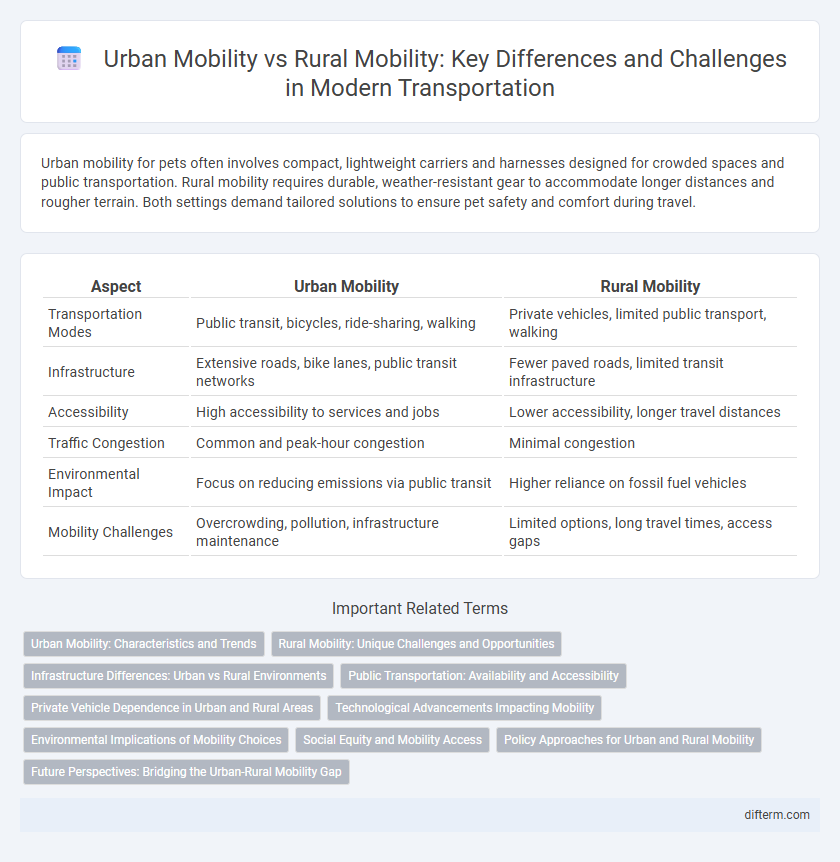Urban mobility for pets often involves compact, lightweight carriers and harnesses designed for crowded spaces and public transportation. Rural mobility requires durable, weather-resistant gear to accommodate longer distances and rougher terrain. Both settings demand tailored solutions to ensure pet safety and comfort during travel.
Table of Comparison
| Aspect | Urban Mobility | Rural Mobility |
|---|---|---|
| Transportation Modes | Public transit, bicycles, ride-sharing, walking | Private vehicles, limited public transport, walking |
| Infrastructure | Extensive roads, bike lanes, public transit networks | Fewer paved roads, limited transit infrastructure |
| Accessibility | High accessibility to services and jobs | Lower accessibility, longer travel distances |
| Traffic Congestion | Common and peak-hour congestion | Minimal congestion |
| Environmental Impact | Focus on reducing emissions via public transit | Higher reliance on fossil fuel vehicles |
| Mobility Challenges | Overcrowding, pollution, infrastructure maintenance | Limited options, long travel times, access gaps |
Urban Mobility: Characteristics and Trends
Urban mobility is characterized by high population density, extensive public transportation networks, and increased use of shared mobility services such as bike-sharing and ride-hailing apps. Trends in urban mobility highlight a growing shift towards sustainable solutions, including electric vehicles, pedestrian-friendly infrastructure, and integrated multimodal transport systems. Smart city technologies and real-time data analytics play a critical role in optimizing traffic flow and reducing congestion in metropolitan areas.
Rural Mobility: Unique Challenges and Opportunities
Rural mobility faces unique challenges such as limited public transportation options, longer travel distances, and inadequate infrastructure, which hinder access to essential services and economic opportunities. Innovative solutions like demand-responsive transit, carpooling programs, and investment in digital connectivity create opportunities to address these barriers. Enhancing rural mobility improves social inclusion, supports local economies, and promotes sustainable development in less densely populated areas.
Infrastructure Differences: Urban vs Rural Environments
Urban mobility benefits from dense infrastructure including extensive public transit systems, well-maintained roads, and abundant cycling lanes, facilitating efficient movement within cities. Rural mobility often faces limited infrastructure, with fewer public transport options, less frequent maintenance of roads, and inadequate pedestrian or cycling facilities, resulting in greater dependence on private vehicles. These infrastructure disparities directly impact accessibility, travel time, and transportation costs between urban and rural environments.
Public Transportation: Availability and Accessibility
Urban mobility benefits from extensive public transportation networks with high-frequency services, including buses, trams, and metros, ensuring widespread availability and accessibility. In contrast, rural mobility faces limited public transit options, often characterized by infrequent schedules and sparse routes, which restrict access for residents. The disparity in service density and coverage significantly impacts travel convenience and mobility equity between urban and rural areas.
Private Vehicle Dependence in Urban and Rural Areas
Private vehicle dependence varies significantly between urban and rural areas due to differences in infrastructure and access to public transportation. Urban residents often face congestion and limited parking but benefit from alternative mobility options, reducing reliance on personal cars. In contrast, rural populations rely heavily on private vehicles because of sparse public transit networks and greater distances between destinations.
Technological Advancements Impacting Mobility
Technological advancements such as smart traffic management systems and electric vehicle infrastructure have significantly enhanced urban mobility by reducing congestion and lowering emissions. In rural areas, GPS-based navigation and ride-sharing apps improve accessibility and connectivity despite sparse public transit options. The integration of autonomous vehicles presents transformative potential for both urban and rural mobility, promising increased safety and efficiency across diverse environments.
Environmental Implications of Mobility Choices
Urban mobility, dominated by public transit and non-motorized options like cycling and walking, significantly reduces carbon emissions and air pollution compared to rural mobility, which often relies on private vehicles due to limited infrastructure. The higher population density in cities supports efficient transit systems that decrease per capita energy consumption and greenhouse gas outputs. In contrast, expansive rural areas face challenges in implementing sustainable mobility solutions, leading to greater environmental impacts from fuel consumption and vehicle emissions.
Social Equity and Mobility Access
Urban mobility offers greater social equity through diversified transportation options such as buses, subways, and bike-sharing systems, enhancing accessibility for low-income and marginalized populations. Rural mobility faces challenges including limited public transit infrastructure and longer travel distances, reducing access to essential services and employment opportunities. Improving mobility access in rural areas requires targeted investments in affordable, reliable transportation solutions to bridge the equity gap between urban and rural communities.
Policy Approaches for Urban and Rural Mobility
Policy approaches for urban mobility emphasize integrated public transit systems, congestion pricing, and investments in pedestrian and cycling infrastructure to reduce traffic congestion and emissions. In contrast, rural mobility policies prioritize improving road connectivity, demand-responsive transport services, and affordable vehicle access to address longer distances and limited public transit options. Tailored strategies considering population density, geographic challenges, and economic resources are essential for effective mobility planning in both urban and rural contexts.
Future Perspectives: Bridging the Urban-Rural Mobility Gap
Emerging technologies like autonomous vehicles and advanced public transit systems promise to transform both urban and rural mobility by enhancing connectivity and reducing travel times. Investments in smart infrastructure and integrated mobility platforms enable seamless transportation experiences, addressing unique challenges such as limited rural transit options and urban congestion. Data-driven approaches and policy innovations aim to bridge the urban-rural divide, fostering equitable access to sustainable mobility solutions and economic opportunities.
urban mobility vs rural mobility Infographic

 difterm.com
difterm.com